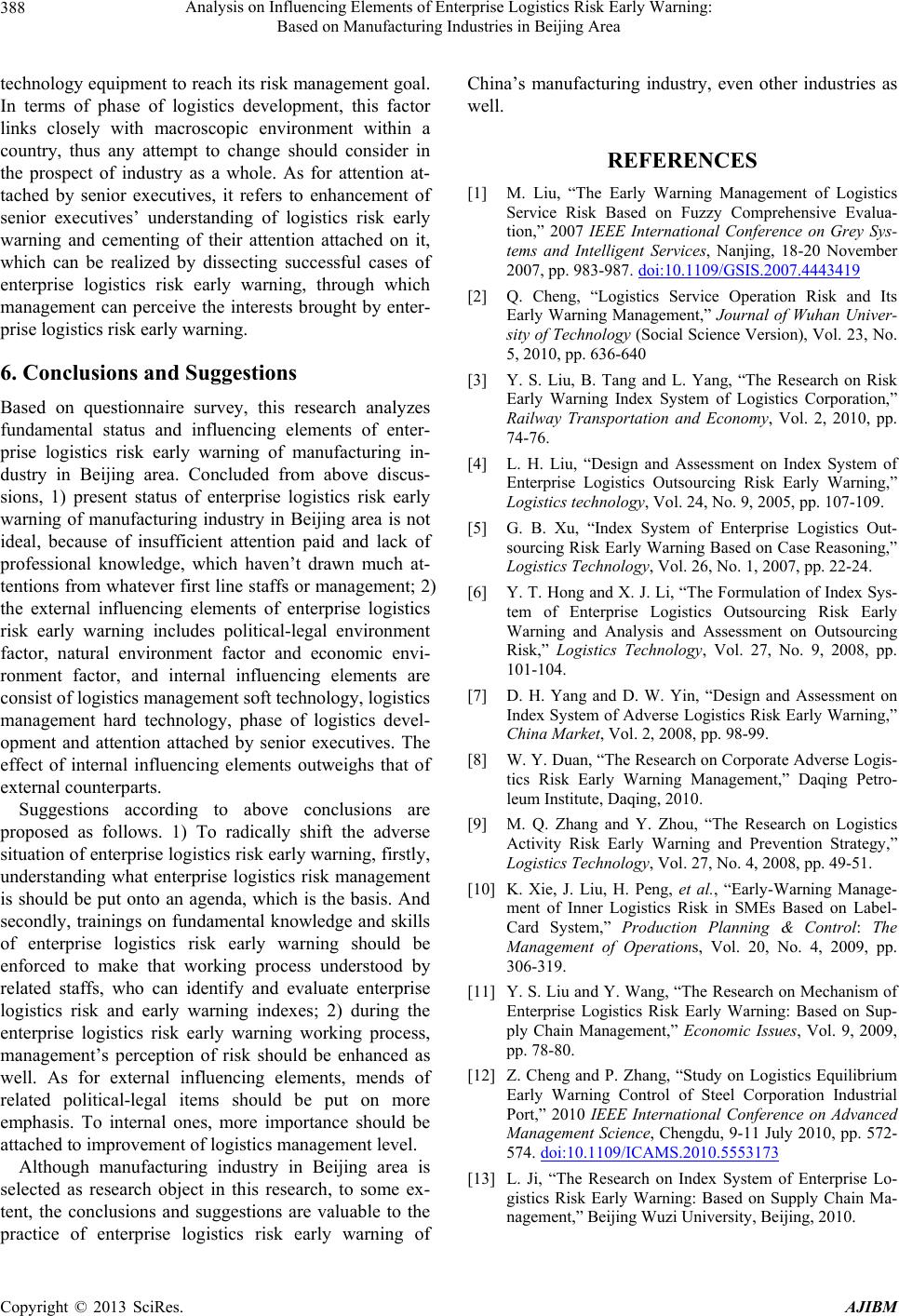
Analysis on Influencing Elements of Enterprise Logistics Risk Early Warning:
Based on Manufacturing Industries in Beijing Area
388
technology equipment to reach its risk management goal.
In terms of phase of logistics development, this factor
links closely with macroscopic environment within a
country, thus any attempt to change should consider in
the prospect of industry as a whole. As for attention at-
tached by senior executives, it refers to enhancement of
senior executives’ understanding of logistics risk early
warning and cementing of their attention attached on it,
which can be realized by dissecting successful cases of
enterprise logistics risk early warning, through which
management can perceive the interests brought by enter-
prise logistics risk early warning.
6. Conclusions and Suggestions
Based on questionnaire survey, this research analyzes
fundamental status and influencing elements of enter-
prise logistics risk early warning of manufacturing in-
dustry in Beijing area. Concluded from above discus-
sions, 1) present status of enterprise logistics risk early
warning of manufacturing industry in Beijing area is not
ideal, because of insufficient attention paid and lack of
professional knowledge, which haven’t drawn much at-
tentions from whatever first line staffs or management; 2)
the external influencing elements of enterprise logistics
risk early warning includes political-legal environment
factor, natural environment factor and economic envi-
ronment factor, and internal influencing elements are
consist of logistics management soft technology, logistics
management hard technology, phase of logistics devel-
opment and attention attached by senior executives. The
effect of internal influencing elements outweighs that of
external counterparts.
Suggestions according to above conclusions are
proposed as follows. 1) To radically shift the adverse
situation of enterprise logistics risk early warning, firstly,
understanding what enterprise logistics risk management
is should be put onto an agenda, which is the basis. And
secondly, trainings on fundamental knowledge and skills
of enterprise logistics risk early warning should be
enforced to make that working process understood by
related staffs, who can identify and evaluate enterprise
logistics risk and early warning indexes; 2) during the
enterprise logistics risk early warning working process,
management’s perception of risk should be enhanced as
well. As for external influencing elements, mends of
related political-legal items should be put on more
emphasis. To internal ones, more importance should be
attached to improvement of logistics management level.
Although manufacturing industry in Beijing area is
selected as research object in this research, to some ex-
tent, the conclusions and suggestions are valuable to the
ractice of enterprise logistics risk early warning of
China’s manufacturing industry, even other industries as
well.
p
REFERENCES
[1] M. Liu, “The Early Warning Management of Logistics
Service Risk Based on Fuzzy Comprehensive Evalua-
tion,” 2007 IEEE International Conference on Grey Sys-
tems and Intelligent Services, Nanjing, 18-20 November
2007, pp. 983-987. doi:10.1109/GSIS.2007.4443419
[2] Q. Cheng, “Logistics Service Operation Risk and Its
Early Warning Management,” Journal of Wuhan Univer-
sity of Technology (Social Science Version), Vol. 23, No.
5, 2010, pp. 636-640
[3] Y. S. Liu, B. Tang and L. Yang, “The Research on Risk
Early Warning Index System of Logistics Corporation,”
Railway Transportation and Economy, Vol. 2, 2010, pp.
74-76.
[4] L. H. Liu, “Design and Assessment on Index System of
Enterprise Logistics Outsourcing Risk Early Warning,”
Logistics technology, Vol. 24, No. 9, 2005, pp. 107-109.
[5] G. B. Xu, “Index System of Enterprise Logistics Out-
sourcing Risk Early Warning Based on Case Reasoning,”
Logistics Technology, Vol. 26, No. 1, 2007, pp. 22-24.
[6] Y. T. Hong and X. J. Li, “The Formulation of Index Sys-
tem of Enterprise Logistics Outsourcing Risk Early
Warning and Analysis and Assessment on Outsourcing
Risk,” Logistics Technology, Vol. 27, No. 9, 2008, pp.
101-104.
[7] D. H. Yang and D. W. Yin, “Design and Assessment on
Index System of Adverse Logistics Risk Early Warning,”
China Market, Vol. 2, 2008, pp. 98-99.
[8] W. Y. Duan, “The Research on Corporate Adverse Logis-
tics Risk Early Warning Management,” Daqing Petro-
leum Institute, Daqing, 2010.
[9] M. Q. Zhang and Y. Zhou, “The Research on Logistics
Activity Risk Early Warning and Prevention Strategy,”
Logistics Technology, Vol. 27, No. 4, 2008, pp. 49-51.
[10] K. Xie, J. Liu, H. Peng, et al., “Early-Warning Manage-
ment of Inner Logistics Risk in SMEs Based on Label-
Card System,” Production Planning & Control: The
Management of Operations, Vol. 20, No. 4, 2009, pp.
306-319.
[11] Y. S. Liu and Y. Wang, “The Research on Mechanism of
Enterprise Logistics Risk Early Warning: Based on Sup-
ply Chain Management,” Economic Issues, Vol. 9, 2009,
pp. 78-80.
[12] Z. Cheng and P. Zhang, “Study on Logistics Equilibrium
Early Warning Control of Steel Corporation Industrial
Port,” 2010 IEEE International Conference on Advanced
Management Science, Chengdu, 9-11 July 2010, pp. 572-
574. doi:10.1109/ICAMS.2010.5553173
[13] L. Ji, “The Research on Index System of Enterprise Lo-
gistics Risk Early Warning: Based on Supply Chain Ma-
nagement,” Beijing Wuzi University, Beijing, 2010.
Copyright © 2013 SciRes. AJIBM